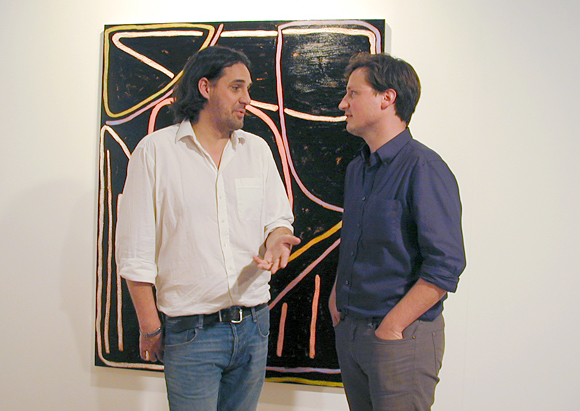
Karl England (left) and Ben Street (right) in front of a painting by Chris Baker presented by George + Jorgen at Sluice. Photo: M-KOS
Sluice Art Fair is a new initiative organized jointly by artist Karl England and Ben Street, curator and art historian. Inaugurated this year in London and launched on the same week as Frieze, M-KOS interviewed England and Street about their project, proposed as an alternative to the alternative art fair.
M-KOS [MK]: How did Sluice come about originally?
Ben Street [BS]: Karl and I met through Twitter. Social networking has been very useful for us. We started just having conversations about art and networking people. Then, last year I was curating an exhibition for an old chapel in the cemetery of North West London. I looked at Karl’s recent work online, I liked it so much I went strait to his studio and decided to put his work in my show. We stayed in touch. Then much later Karl contacted me and said there was a space he was able to use where he had already shown before, and asked me if I was interested in collaborating on something with him during Frieze. The space is only 15 minutes away from the art fair, where so many people come to see art.
Karl England [KE]: Also, we had this space in Mayfair for only three days, that was perfect timing for an art fair but it’s too short for organizing an exhibition.
MK: How did you decide to name it Sluice?
BS: Sluice is a reference to an underground river, called the Tyburn, that runs beneath both Sluice and – coincidentally – Frieze.
MK: When did you start organizing Sluice?
BS: We started around March this year. In fact another friend of ours was going to get involved but couldn’t in the end because of time commitments. So, Karl and I started talking about what kind of art we wanted to show and what kind of galleries we like to go to, which generally speaking often are the ones that are a bit more quirky, perhaps more experimental, perhaps a bit less commercial than the ones you might see at other art fairs like, but not necessarily only Frieze.
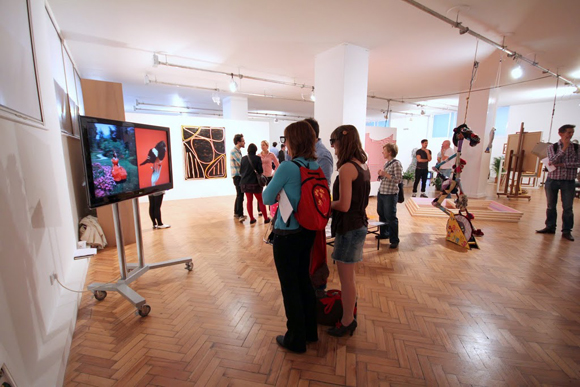
View from Sluice Art Fair. Photo: Laura Mott
MK: So Sluice is kind of the alternative to the alternative art fairs, like Sunday Art Fair which replaced Zoo, which was the first alternative fair to Frieze.
BS: Yes, it is an alternative to the alternative. When we were looking at what Sluice would look like, we were thinking maybe something like Sunday which has an open plan, very free-flowing qualities. We are not going be an anti-Frieze or anti-Sunday fair but we just wanted to present something different to what both of them are doing. Although it turned out quite like Sunday, most of our spaces are artist-run. We like the idea of having closer contacts with practicing artists, that is a key thing for us.
MK: How did you choose the participating galleries? Did they submit to a submission call out or did you simply invite galleries that you were interested in?
KE: A bit of both. We had an open submission and we approached the galleries that we liked as well. We also had different tiers that we wanted to make accessible for smaller projects. Obviously the biggest tiers have the biggest space so they paid the most and then there are smaller second and third tiers to make it affordable. For example, LEDGE projects use the windowsill as a space, behind the performance [a live piece by Alexander Costello was underway at the time of the interview] that’s actually a tiny thing, with no money involved. But we wanted these kinds of projects to get on board, which are usually never in art fairs because there is no budget.
MK: What kind of criteria did you have for choosing galleries or projects?
KE: Stuff we liked really.
BS: We wanted the galleries to put together a proposal for what they would do and a lot of our judgment was based on those proposals as well as on what we thought of the galleries. Obviously, there were proposals we turned down because they didn’t quite fit what we wanted for the fair, and of course when we were installing things last night, things have changed around. But we had a fairy good idea of what we wanted to do beforehand.
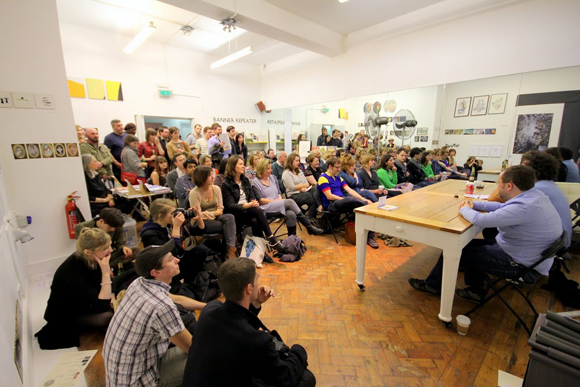
Public talk at Sluice. Photo: Laura Mott
MK: The fair runs only for two days but you organized many programs – performances, talks and also family workshops. Was this your idea because you [Ben Street] also work as an art educator?
BS: I didn’t really want to have an educational component so much as a component that involved interaction for a broader range of people than those who ordinarily interact with works in art fairs.
I work at the National gallery’s historical collection where quite a broad range of people come my way. The two principle ways the public gets involved are with a children’s art workshop, for kids to make their own art and respond to what they saw, and the other way is panel discussions which just happened here, designed to pitch at the audience, in accessible and understandable words. Audiences who come to art fairs are usually the same kinds of audiences who come to galleries but we wanted to at least present a different model of how it could be because educational or interactive components are, I think, really important. Frieze does some educational work but you still have to pay to get in so we wanted to make sure ours are free, even if very casual.
MK: In order to keep the fair free for the audience, what kind of funding or support did you have?
KE: We have a lot of sponsors which helped us to do promotions.
BS: To begin with, we applied for Arts Council funding but we didn’t get any. So we had to rely upon other sponsors. We have a great sponsorship from Artlicks who produces the magazine and also has many active projects and events in London.
KE: They cover the non-commercial London art scene. They also organise events including art tours. They do a lot in South London, Deptford or Peckham area.
BS: Also we had Art Media Contacts, a PR company and we worked with this venue.
KE: This space gave us sponsorship otherwise we couldn’t have afforded it in Mayfair.
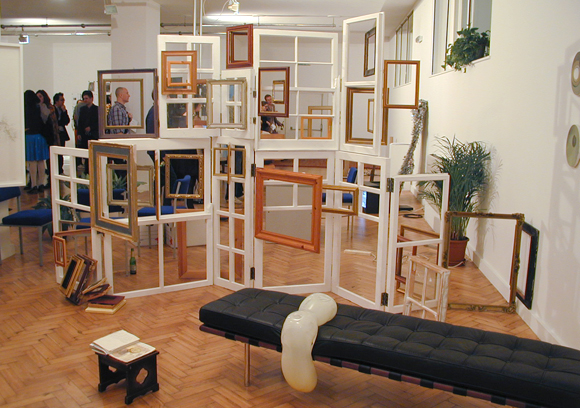
View from Sluice. Photo: M-KOS
BS: We wanted to be reasonable in what we charge for people to have a pitch in the fair. So the three tiers system is part of it. The top tier is really not expensive and galleries can afford it. Some were even surprised it was so reasonable. This is part of our attitude. We wanted to be free, and our programs to be free. I think it has really paid off because so many people have come up to me today saying the atmosphere is so good and it has a welcoming quality which exactly what we wanted. That was a real measure of success, I think.
KE: We’ve done a lot of work to get this going, and getting our identity out into the media.
BS: We have been very lucky in terms of the media, the amount of press coverage we had, that was a testament to our public relations. I think also people were really excited about Sluice and what we offer as a kind of alternative.
MK: A big fair like Frieze brings a lot of hype but tends to get oversaturated and becomes a bit predictable that is why people seem to get very excited about other alternatives…
KE: The galleries in Sluice are out there during Frieze but they are not in the West End, most of them are in the East End, and not many people necessarily travel there. So the idea is also brings the East End galleries to the West End during the fair, to make them accessible.
MK: Have you had any collectors come along?
KE: Apparently there have been interested people around and there have been sales.
BS: Strictly speaking we haven’t marketed ourselves as a commercial art fair but it is still an art fair and there are still object-based works here and they can be bought and sold. But this is not our guiding principle, not our main aim.
KE: And for most of the galleries it is not their principle, either.
BS: That’s the whole point of our low participation fee. Galleries come here, not to sell anything but they are still not out of pocket.
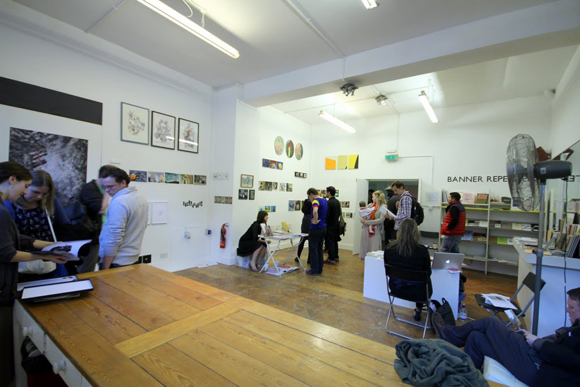
View from Sluice. Photo: Laura Mott
MK: You said that you primarily selected artist-run spaces. Is this your fundamental criteria?
BS: I think the fundamental criteria is to support small spaces, not only artist-run spaces but also young curator-run or emerging galleries.
KE: We didn’t want to make it narrow. It would have been much easier to say we have only artist-run spaces but we don’t and it’s not that simple.
MK: Do you both have same kind of taste?
KE: No.
BS: Actually, we often find we don’t.
KE: We both like my work.
BS: Yes we are both big Karl England fans (Laugh). We like different things. We both like everything in Sluice but there are things we are more drawn to than others. Also I don’t think I would go to a show to see only things that I like. You want to see shows that slightly expand your taste or expose you to new things, don’t you? So this works well as a partnership.
MK: Are the participating galleries all from UK or are they international?
BS: Most of the galleries are UK based.
KE: And mostly are in London but because that’s what we know best.
BS: It is a starting point. There is a gallery from Cambridge although it’s still in Britain. We also promoted and launched a magazine/book at Sluice that is from Amsterdam. And there is also a gallery from New York showing an artist from London, which is great for us to be able to have different collections of galleries and projects.
KE: An art fair is a great place for these small galleries to network with each other.
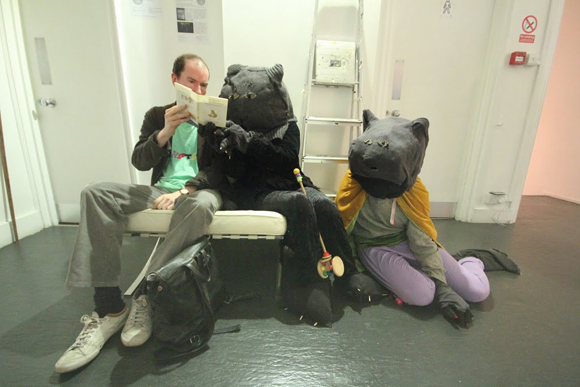
Performance by Edwina Ashton. Photo: Laura Mott
MK: Do you want to talk about performances and other events as well?
BS: Karl and I don’t have that much of a background in performance but we wanted performers to get involved and we managed to get a very good line-up of artists.
KE: Did you see Edwina Ashton’s performance earlier? That was brilliant.
BS: Edwina Ashton and another artist, Julia McKinley, dressed as cats and were not really doing anything just paring nails but they ask members of the public to read a book for them and they were just listening. It was absolutely fantastic. It is important for us to have a sense that it is an event, things happening – kids drawing, people talking about what art fairs are, people dressing up like cats, also a live video streaming of two artists playing squash in their studio in East London, and so on. Sometimes I found that going to art fairs but not going to any fancy openings makes you think you missed the party. I remember that when I went to the Venice Biennale a few of years back, there was a performance by Michelangelo Pistoletto who I really like, he smashed all these mirrors but obviously the public didn’t see him smashing mirrors but just the broken glass on the floor. I wish I was invited for the performance. So having this live element is really important.
KE: There is also other performance by Ladies of the Press tomorrow night. They are really good.
BS: These performances show our attitudes, that is a little bit jokey but they’re not. It’s a kind of serious joking. The video of squash players was an excellent work of art because it ties in with the history of performance art, like Bruce Nauman and so on. It’s very lively and it’s got to do with the idea of competition as well as the artist studio being a ‘sacred ground’.
I have to admit I was a little bit intimidated by doing performances because I had some preconceptions about what it might be but it has been a really fantastic element of the whole thing.
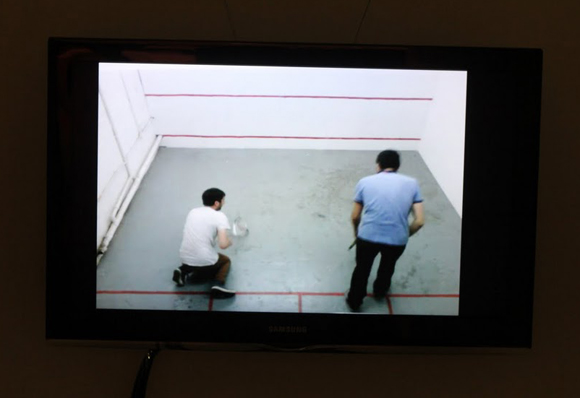
Simon Linington and William Mackrell “Take Two” presented by Space In Between gallery. Photo: Laura Mott
MK: How was the talk?
BS: It was really heated and quite passionate. We discussed the nature of art fairs, problems of art fairs, whether or not Sluice is an art fair and how we want to define it. One of our main interest in Sluice is that how it affect artists, how they feel about an element of competition or do they feel encouraged to make more work. We discussed about whether success could be fatal for artists or be a spur of stimulus. It was very interesting and there were a lot of interaction with the audience.
MK: Has many people come to see the fair so far?
KE: We are counting them. [Karl checks a counter] So far we had more than 578 people!
BS: That’s great!
KE: We didn’t know what to expect, especially during Frieze there is lots going on, so we had no idea.
BS: The whole thing was based on good will and people getting involved because they believe in it. We had really brilliant volunteers, some students and graduates and they really pitched in. All the people brought up a lot of good energy and also a sense of community.
MK: Do you want to continue next year?
BS: We haven’t really talked about that yet. But today someone has come up to me and said they want to make a proposal for the next year. It was a gallery from Birmingham. Definitely we would like to continue next year. Once the dust is settled and we get back to our normal sleeping pattern then we will be able to think about our next move. I think it’s very likely. â–
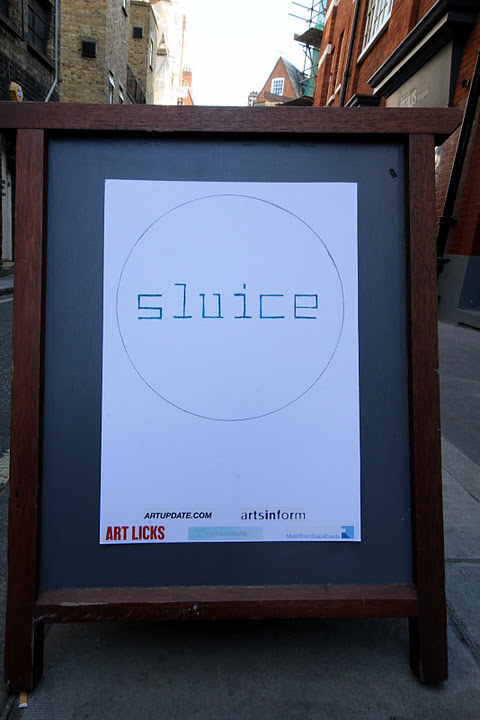
Photo: Laura Mott
